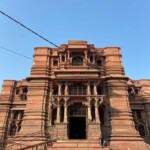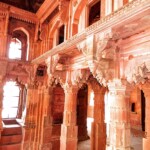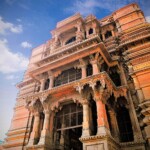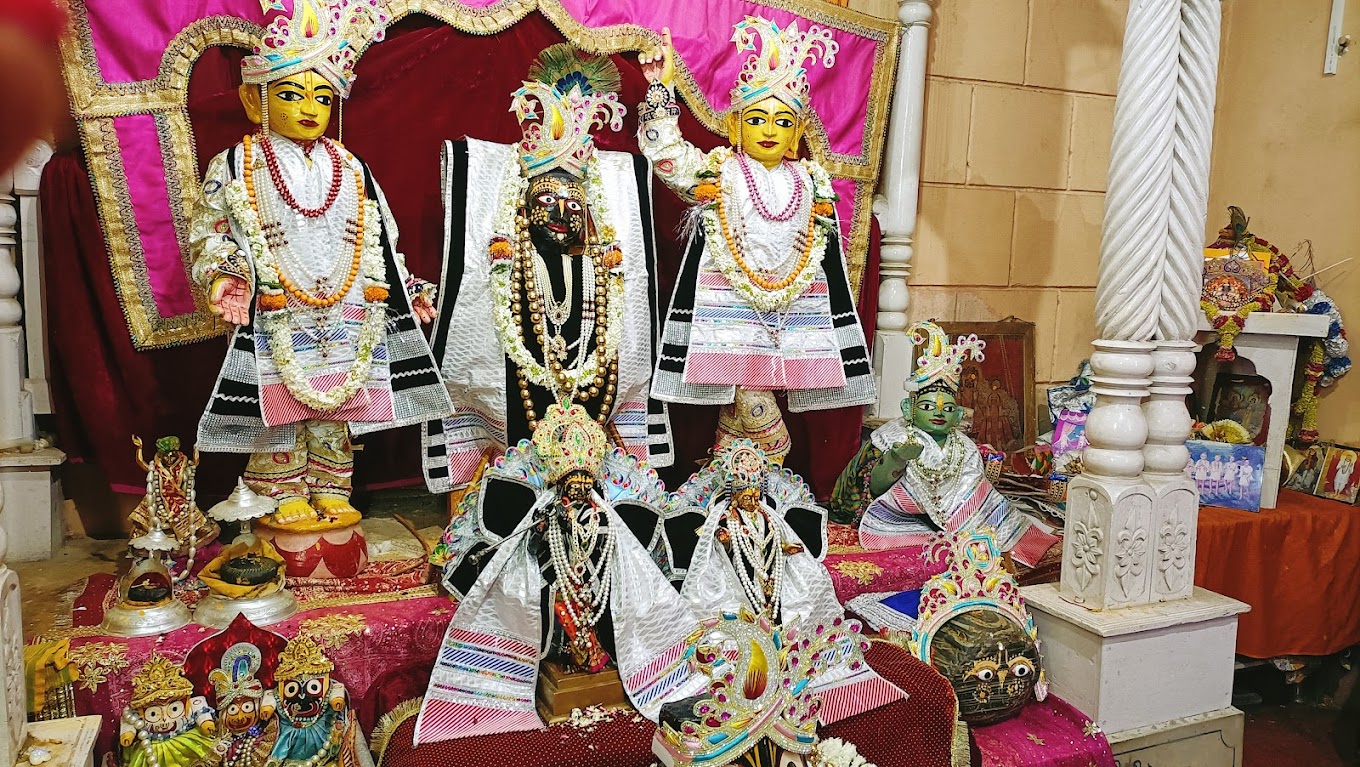
The Govind Dev Ji Temple, also known as the Radha Govind Dev Temple, stands as a magnificent symbol of Hindu devotion in the sacred city of Vrindavan. This revered temple is an absolute must-visit for those seeking spiritual solace, dedicated to the divine form of Lord Krishna known as Govind Dev Ji.
What truly captivates visitors to Govind Dev Ji Temple Vrindavan is its breathtaking architectural splendor. This architectural marvel was meticulously crafted from exquisite red sandstone nearly half a millennium ago.
Originally, the temple was a towering seven-storey edifice, a testament to its grandeur. However, it endured destruction during the reign of Aurangzeb, leaving only three stories to grace us with their presence today. During those tumultuous times, the idol of Govind Dev Ji was safeguarded in Jaipur, while a faithful replica took its place within the sanctified confines of this holy temple in Vrindavan.
Stepping into the Govind Dev Ji Mandir Vrindavan is to step into a world steeped in spirituality. The temple exudes a profound sense of serenity and offers a visual feast for all who enter. It stands as a tranquil oasis in the sacred town of Vrindavan, a place where it is believed that the Lord Himself performed countless miraculous deeds.
Govind Dev ji Vrindavan Timings
| Monday | |
| Tuesday | |
| Wednesday | |
| Thursday | |
| Friday | |
| Saturday | |
| Sunday |
History of Govind Dev Ji Temple
The history of the Govind Dev Ji Temple is a tale woven with threads of devotion and resilience, set against the backdrop of Vrindavan’s timeless spirituality. This temple, also known as the Radha Govind Dev Temple, has a captivating history that dates back to the 16th century.
Origin and Legends:
The Govind Dev Ji Temple was established by Raja Man Singh of Amber in the 16th century. According to cherished legends, the temple’s main idol, that of Lord Krishna in His Govind Dev Ji form, was brought from Vrindavan, the celestial abode of Lord Krishna Himself. This idol holds immense significance for devotees, as it is believed to be an exact replica of Lord Krishna during His time in Vrindavan.
Architectural Marvel:
The temple’s architectural beauty is another facet of its history that cannot be overlooked. Crafted nearly 500 years ago, this temple is a striking example of Rajasthani and Mughal architectural styles seamlessly blending together. Its red sandstone exterior and intricate marble carvings are a testament to the artistic prowess of its builders.
Aurangzeb’s Impact:
However, history also bears witness to the trials faced by the Govind Dev Ji Temple. During the reign of the Mughal Emperor Aurangzeb, the temple suffered significant damage. Originally a towering seven-storey structure, it was reduced to just three storeys due to destruction during this tumultuous period.
Preservation and Replica:
In an effort to safeguard the precious idol of Govind Dev Ji, it was moved to Jaipur for safekeeping during these turbulent times. Within the hallowed walls of the temple in Vrindavan, a faithful replica of the ancient idol was installed, ensuring that the divine presence of Lord Krishna continued to bless devotees.
The history of the Govind Dev Ji Temple is a testament to the unwavering devotion of its patrons and the enduring spirit of Vrindavan as a hub of Hindu spirituality. Today, this temple stands not only as a place of worship but also as a living testament to the rich history and cultural heritage of this sacred city.
Images of Govind Dev Ji Temple Vrindavan
Govind Dev Ji Temple Vrindavan Timing
Govind Dev Ji Temple in Vrindavan follows a specific schedule for darshan (viewing of the deity) and other rituals. Here are the general timings for the temple:
1. Morning Darshan:
- The temple typically opens early in the morning, usually around 4:30 AM to 5:00 AM.
- Devotees can attend the Mangala Aarti, the first aarti of the day, which is a serene and spiritually uplifting experience.
- Morning darshan continues until around 12:00 PM.
2. Afternoon Break:
- There is often a break in the temple’s schedule during the afternoon hours, usually from 12:00 PM to 4:00 PM.
- During this time, the temple doors may be closed, allowing for rest and preparation for the evening rituals.
3. Evening Darshan:
- The temple reopens in the late afternoon or early evening, typically around 4:00 PM to 4:30 PM.
- Devotees can attend the Sandhya Aarti, the evening aarti ceremony, which is another spiritually significant event.
- Evening darshan continues until around 8:00 PM.
Please note that these timings are approximate and may vary slightly depending on the time of year and specific temple practices. It’s a good idea to check with the temple authorities or your accommodation for the most up-to-date timings before planning your visit.
Devotees and visitors are encouraged to arrive a bit earlier than the scheduled aarti times to secure a good spot for darshan and to fully participate in the spiritual rituals and hymns that accompany the aarti ceremonies.
Architecture of Govind Dev Ji Temple Vrindavan
The architecture of Govind Dev Ji Temple in Vrindavan is a masterpiece that seamlessly fuses the distinct styles of Rajasthan and Mughal architecture, creating a visual spectacle that leaves visitors in awe.
Rajasthani Influence:
One of the defining features of the temple’s architecture is its strong Rajasthani influence. The use of red sandstone, a hallmark of Rajasthani architecture, gives the temple its striking appearance. The rich, earthy tones of the sandstone are complemented by intricate marble carvings that adorn the exterior of the temple. These carvings depict scenes from Hindu mythology, adding to the temple’s visual appeal and religious significance.
Mughal Inspiration:
While Rajasthani architecture dominates the exterior, the temple also incorporates elements of Mughal design. The temple’s spires, for instance, bear resemblance to the distinctive Mughal minarets. These towering structures are adorned with ornate detailing and provide a majestic backdrop to the temple’s main sanctum.
Seven-Storey Marvel:
Originally, the Govind Dev Ji Temple was a seven-storey architectural marvel. Each floor was adorned with unique architectural features, showcasing the craftsmanship of its builders. Sadly, during the reign of Aurangzeb, the temple endured significant damage, reducing it to its current three-storey form.
Intricate Marble Work:
The temple’s interior is a sanctuary of intricate marble work. Delicate carvings, floral motifs, and intricate patterns grace the inner sanctum, creating an atmosphere of divine grandeur. The central altar, where the idol of Lord Krishna resides, is a work of art in itself, drawing the gaze of devotees and tourists alike.
Courtyard and Surroundings:
The temple’s architectural brilliance extends to its courtyard and surrounding structures. The open courtyard is a serene space where devotees gather for various rituals and ceremonies. The temple’s surroundings are beautifully landscaped, creating a tranquil environment that complements the spiritual aura of the place.
The architecture of Govind Dev Ji Temple Vrindavan is a harmonious blend of Rajasthani and Mughal styles, showcasing the artistic genius of its builders. Its red sandstone façade, intricate marble carvings, and towering spires make it a visual delight, while the temple’s inner sanctum offers a divine experience that leaves a lasting impression on all who visit this sacred place.
Importance of the Govind Dev Ji Temple Vrindavan
The Govind Dev Ji Temple in Vrindavan holds immense significance, both spiritually and culturally, making it a revered and cherished place for devotees and visitors alike.
Here are some key aspects highlighting the importance of this historic temple:
1. Spiritual Significance:
The temple is dedicated to Lord Krishna in His Govind Dev Ji form, making it a place of deep spiritual reverence for Krishna devotees. The deity’s presence here is believed to be an exact replica of Lord Krishna during His time in Vrindavan. This connection draws devotees from all over the world who seek spiritual solace and divine blessings.
2. Historical Heritage:
The temple’s rich history dates back to the 16th century when it was established by Raja Man Singh of Amber. It stands as a testament to the enduring cultural and architectural heritage of India. Despite facing adversities during its history, the temple has stood the test of time and continues to inspire awe with its architecture and traditions.
3. Architectural Marvel:
The Govind Dev Ji Temple is a striking blend of Rajasthani and Mughal architectural styles. Its magnificent red sandstone façade and intricate marble carvings showcase the artistic prowess of its builders. The temple’s architecture is a visual treat for visitors and adds to its cultural significance.
4. Rituals and Festivals:
The temple is a hub of religious activities, and its daily rituals and festivals are a vibrant celebration of Hindu traditions. The enchanting aarti ceremony held twice a day is a major attraction, drawing devotees and tourists alike to witness the divine spectacle of oil lamps, incense, and devotional hymns.
5. Cultural Heritage:
Govind Dev Ji Temple plays a crucial role in preserving and promoting India’s cultural heritage. It is a living testament to the religious and artistic traditions that have thrived in the region for centuries. The temple’s festivals, music, and rituals are a vibrant representation of India’s diverse cultural tapestry.
6. Janmashtami Celebrations:
The temple comes alive during Janmashtami, the celebration of Lord Krishna’s birth. The festivities are grand and attract pilgrims and tourists in large numbers. Processions, devotional music, and a lively atmosphere mark this important festival, making it a unique cultural experience.
7. Center of Devotion:
Govind Dev Ji Temple Vrindavan is a place where devotees can immerse themselves in deep devotion and connect with the divine. The serene ambiance and spiritual aura of the temple create an atmosphere conducive to introspection and prayer.
The Govind Dev Ji Temple in Vrindavan is not just a religious site; it is a living testament to India’s rich cultural and spiritual heritage. Its importance transcends time, attracting people from various walks of life who seek solace, inspiration, and a deeper connection with the divine.
Things to do at Govind Dev Ji Temple Vrindavan
Visiting the Govind Dev Ji Temple in Vrindavan offers a multitude of enriching experiences and activities for devotees and tourists alike.
Here are some things you can do when you visit this sacred place:
1. Attend Aarti: – Witness the mesmerizing aarti ceremony held twice daily at the temple. It’s a captivating ritual filled with the divine glow of oil lamps, fragrant incense, and melodious hymns. Joining the aarti is a spiritually uplifting experience.
2. Seek Blessings: – Pay your respects and seek blessings from the idol of Lord Krishna in His Govind Dev Ji form. Devotees believe that the deity here grants blessings and fulfills their wishes.
3. Explore the Architecture: – Take your time to admire the stunning architectural beauty of the temple. Marvel at the red sandstone exterior, intricate marble carvings, and the towering spires that make the temple a visual delight.
4. Meditate and Reflect: – The serene ambiance of the temple and its peaceful surroundings make it an ideal place for meditation and reflection. Find a quiet corner and connect with your inner self amidst the spiritual aura.
5. Participate in Festivals: – If your visit coincides with a Hindu festival, such as Janmashtami, immerse yourself in the vibrant celebrations. Join the processions, witness the rituals, and experience the joyous atmosphere.
6. Visit the Courtyard: – Spend time in the temple’s courtyard, where you can observe various religious activities, interact with devotees, and absorb the spiritual energy of the place.
7. Explore the Surroundings: – Vrindavan is a town rich in history and spirituality. Take the opportunity to explore other nearby temples and sacred sites, each with its own unique significance.
8. Photography (with Permission): – Capture the temple’s beauty and the moments of devotion with your camera. However, be sure to inquire about photography policies, as some areas may have restrictions.
9. Attend Discourses and Bhajans: – Many temples in Vrindavan organize discourses on spiritual topics and bhajan (devotional song) sessions. Check the temple’s schedule to see if any such events are happening during your visit.
10. Interact with Devotees: – Engage with the local devotees and learn about their devotion and experiences. It’s an opportunity to gain insights into the spiritual significance of the temple.
11. Visit the Temple Store: – Most temples have stores where you can purchase souvenirs, religious items, and prasad (blessed offerings). Support the temple and take home a token of your visit.
Visiting Govind Dev Ji Temple Vrindavan is not just about sightseeing; it’s a holistic experience that allows you to immerse yourself in spirituality, culture, and the divine aura of Lord Krishna. Enjoy your visit and make the most of the enriching activities this sacred place has to offer.
Interesting Facts about Govind Dev Ji Temple Vrindavan
The Govind Dev Ji Temple in Vrindavan is a place steeped in history, spirituality, and cultural significance.
Here are some interesting facts about this revered temple:
- Idol Replica: The main idol of Lord Krishna in His Govind Dev Ji form in this temple is believed to be an exact replica of the original deity, which was moved to Jaipur for safekeeping during challenging times. This replica continues to attract devotees from far and wide.
- Architectural Grandeur: The temple’s architecture is a stunning blend of Rajasthani and Mughal styles. Its red sandstone exterior, intricately carved marble facades, and towering spires make it a visual masterpiece, showcasing the artistic brilliance of its builders.
- Aarti Ceremonies: The temple hosts captivating aarti ceremonies twice daily. The aarti is a sensory delight, with the illumination of oil lamps, the fragrance of incense, and the melodious chanting of hymns creating a deeply spiritual atmosphere.
- Janmashtami Celebrations: Govind Dev Ji Temple comes alive during Janmashtami, the celebration of Lord Krishna’s birth. The festivities are grand and include processions, devotional music, and a vibrant atmosphere that attracts pilgrims and tourists in large numbers.
- Historical Significance: The temple’s history dates back to the 16th century when it was established by Raja Man Singh of Amber. It has withstood the test of time, surviving damage during the reign of Aurangzeb.
- Spiritual Oasis: The temple provides a serene and spiritually uplifting experience for visitors. Its tranquil ambiance and the presence of Lord Krishna’s deity make it a place for deep reflection and devotion.
- Cultural Hub: Govind Dev Ji Temple plays a pivotal role in preserving and promoting India’s cultural heritage. Its festivals, rituals, and devotional music are a vibrant representation of India’s diverse cultural tapestry.
- Devotee’s Paradise: Devotees believe that seeking blessings at this temple fulfills their wishes and brings prosperity. Many people visit the temple to find solace and seek divine intervention in their lives.
- Courtyard Gatherings: The temple’s courtyard is often a place where devotees gather for various religious activities, including singing bhajans (devotional songs), making it a lively and interactive space.
- Photography Restrictions: While photography is generally allowed in many parts of the temple, some areas may have restrictions, especially during religious ceremonies. It’s advisable to inquire about photography policies before taking pictures.
- Temple Store: Most temples in Vrindavan have stores where you can purchase religious items, souvenirs, and prasad (blessed offerings). These items are a meaningful way to remember your visit and support the temple.
Govind Dev Ji Temple Vrindavan is not just a place of worship; it’s a living testament to India’s rich cultural and spiritual heritage. Its historical significance, architectural splendor, and spiritual resonance make it a must-visit destination for those seeking a deeper connection with Lord Krishna and the essence of Hindu spirituality.
Festivals at Govind Dev Ji Temple Vrindavan
Govind Dev Ji Temple in Vrindavan is a vibrant center of devotion and spirituality, and it hosts several festivals throughout the year that attract devotees and tourists alike. These festivals are marked by grand celebrations, religious rituals, and a joyful atmosphere.
Here are some of the significant festivals celebrated at Govind Dev Ji Temple:
1. Janmashtami:
Janmashtami, the celebration of Lord Krishna’s birth, is the most significant and grand festival at Govind Dev Ji Temple. The temple comes alive with elaborate decorations, processions, and devotional music. The main highlight is the midnight celebration of Lord Krishna’s birth, with fervent prayers, bhajans, and aarti ceremonies.
2. Holi:
Holi, the festival of colors, is celebrated with great enthusiasm at the temple. Devotees and visitors gather to play with vibrant colors, sing Holi songs, and partake in the joyous festivities. The temple courtyard becomes a colorful canvas of unity and celebration.
3. Diwali:
Diwali, the Festival of Lights, is another important celebration at Govind Dev Ji Temple. The temple is adorned with thousands of oil lamps, creating a mesmerizing sight. Devotees offer prayers, perform aarti, and seek the blessings of Lord Krishna on this auspicious occasion.
4. Radhashtami:
Radhashtami is the celebration of the divine appearance of Radha, Lord Krishna’s beloved consort. Devotees gather at the temple to honor Radha’s devotion and love for Lord Krishna through special rituals and prayers.
5. Guru Purnima:
Guru Purnima is a day dedicated to expressing gratitude to spiritual teachers and gurus. Devotees visit the temple to offer their respects to Lord Krishna as their ultimate guru and seek His blessings for spiritual guidance.
6. Annakut Utsav:
Annakut Utsav is a unique festival where an elaborate offering of various vegetarian dishes is made to Lord Krishna. Devotees prepare a wide variety of food items, and a grand display is arranged in front of the deity as an expression of devotion and gratitude.
7. Rathyatra:
Rathyatra is a chariot procession festival during which the idol of Lord Krishna is placed on a beautifully decorated chariot and pulled through the streets of Vrindavan. This event attracts a large gathering of devotees and onlookers who participate in the procession and seek the Lord’s blessings.
8. Kartik Purnima:
Kartik Purnima is a sacred day dedicated to performing rituals and prayers to Lord Krishna during the auspicious month of Kartik (October-November). Devotees light oil lamps and offer prayers for spiritual progress.
These festivals at Govind Dev Ji Temple Vrindavan not only celebrate the life and teachings of Lord Krishna but also create a sense of unity and devotion among the devotees. They provide a unique opportunity for visitors to immerse themselves in the rich cultural and spiritual heritage of Vrindavan and experience the profound love and devotion associated with Lord Krishna.
Places to visit near Govind Dev Ji Temple Vrindavan
Vrindavan, the city of temples and spirituality, offers a plethora of enchanting places to visit near Govind Dev Ji Temple.
Here are some notable destinations that you can explore to enhance your Vrindavan experience:
1. Banke Bihari Temple:

Located just a short walk from Govind Dev Ji Temple, the Banke Bihari Temple is one of the most revered Krishna temples in Vrindavan. It is known for its unique idol of Lord Krishna, and the atmosphere here is filled with devotion and music.
2. Radha Raman Temple:

This temple is dedicated to Lord Krishna and is famous for its exquisite deity of Radha Raman. The temple’s architecture and serene ambiance make it a must-visit for spiritual seekers.
3. Prem Mandir:

A relatively newer addition to Vrindavan’s temple landscape, Prem Mandir is a majestic white marble temple dedicated to Lord Krishna and Radha. The temple is known for its intricate carvings and beautiful lighting during the evening.
4. ISKCON Temple:

The International Society for Krishna Consciousness (ISKCON) temple in Vrindavan is a hub of spirituality and devotion. It offers a peaceful environment, beautiful idols, and regular discourses on spiritual topics.
5. Nidhivan:

Nidhivan is a sacred forest where it is believed that Lord Krishna and Radha perform their divine pastimes every night. It is a serene place to visit, especially during sunset.
6. Seva Kunj and Nidhi Van:
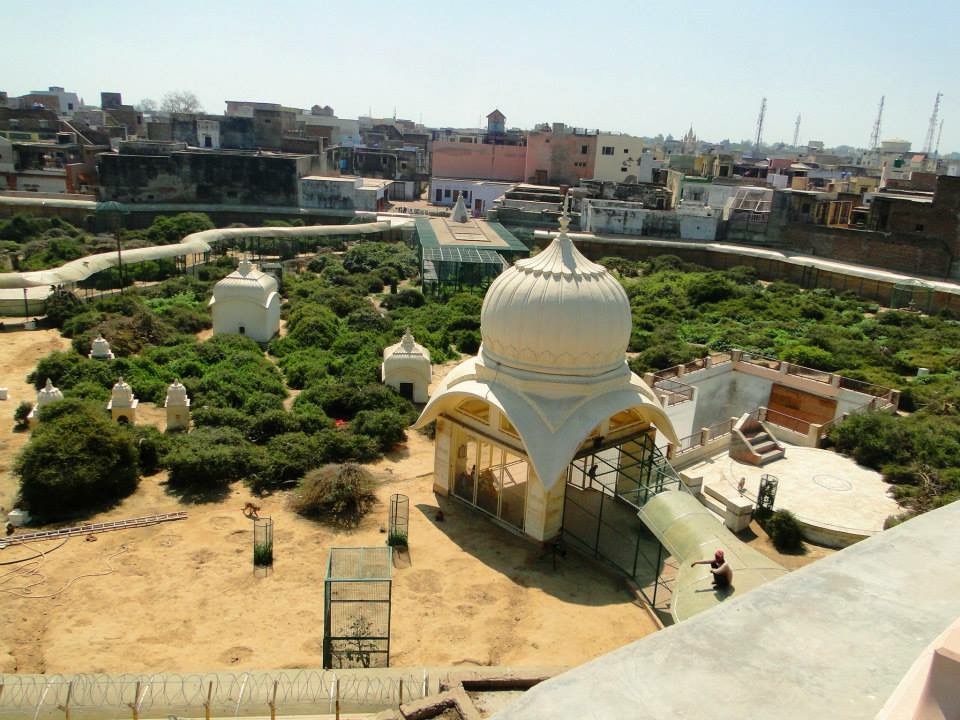
These lush gardens are associated with the divine love story of Lord Krishna and Radha. Devotees come here to offer prayers and immerse themselves in the divine atmosphere.
7. Madan Mohan Temple:
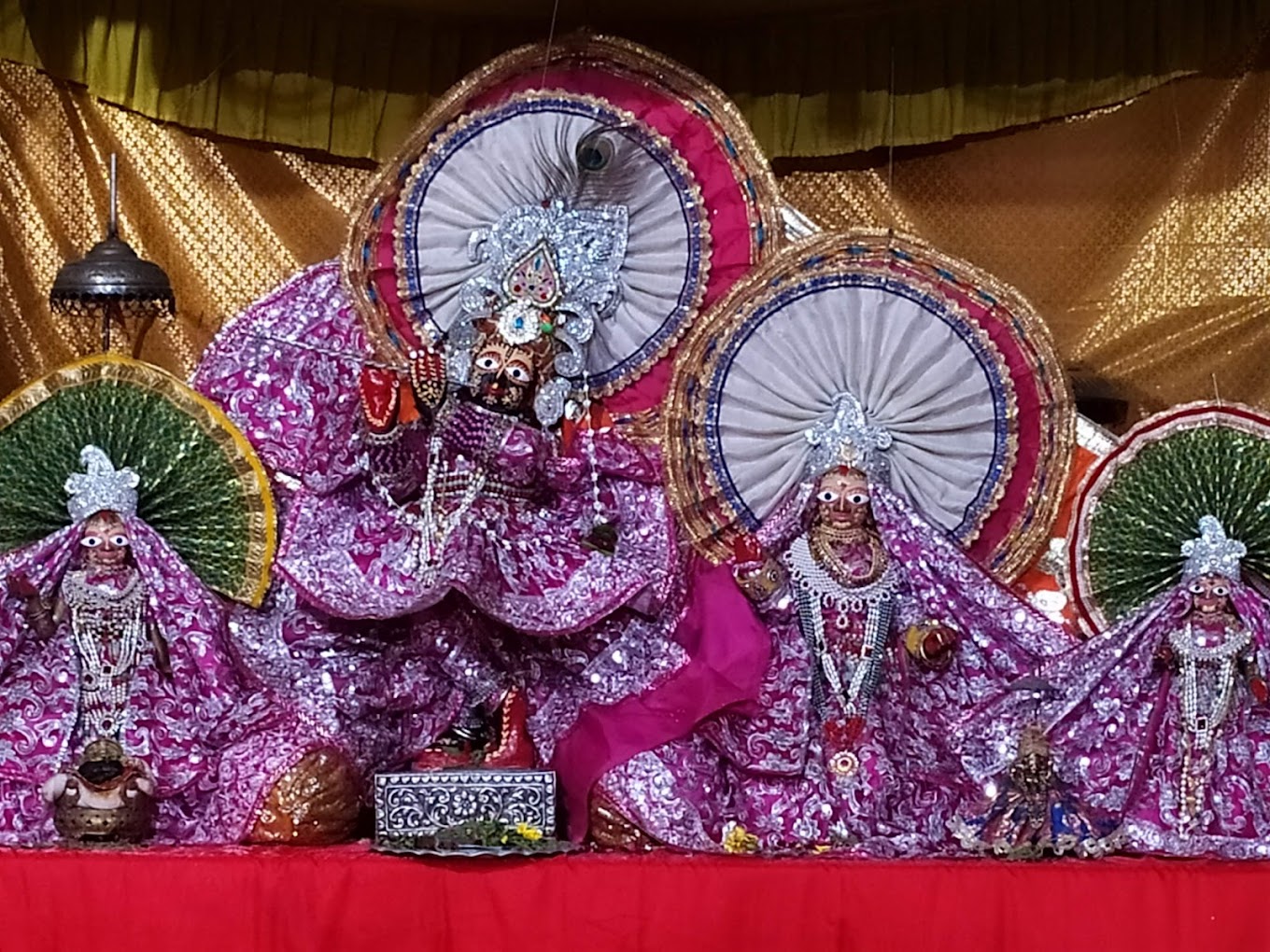
Another historic temple in Vrindavan, the Madan Mohan Temple is dedicated to Lord Krishna and is renowned for its beautiful deity and tranquil surroundings.
8. Kusum Sarovar:
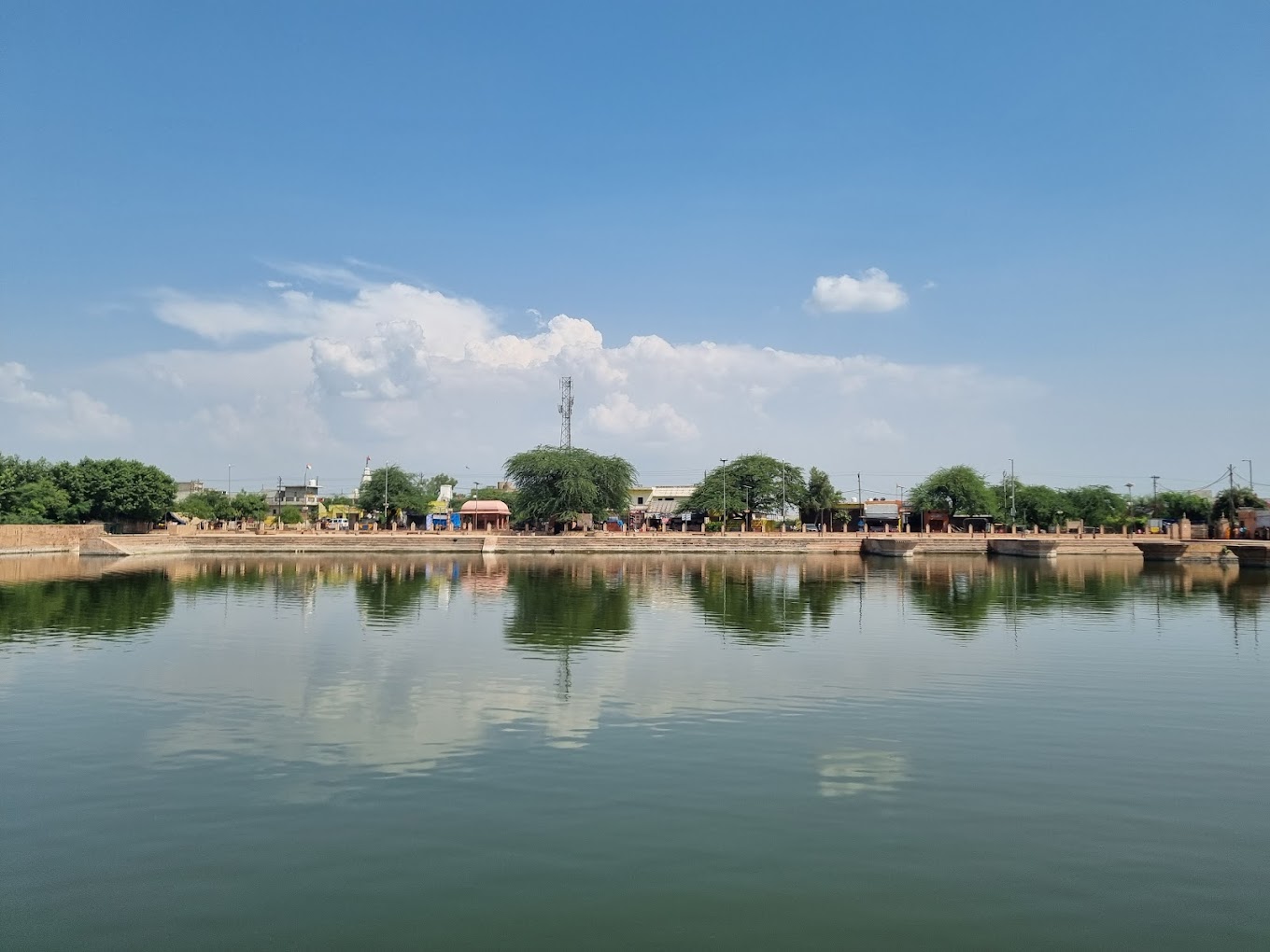
Kusum Sarovar is a picturesque lake surrounded by sandstone steps and lush gardens. It is a serene spot to relax and reflect on the spiritual essence of Vrindavan.
9. Govardhan Hill:

A short drive from Vrindavan, Govardhan Hill holds immense religious significance. It is believed to be the very hill lifted by Lord Krishna to protect the villagers from Lord Indra’s wrath.
10. Radha Kund and Shyam Kund:

These sacred ponds are associated with the eternal love of Radha and Krishna. Pilgrims come here to take a holy dip and seek spiritual purification.
11. Gokul and Mathura:
These nearby towns are closely associated with Lord Krishna’s childhood and early life. You can visit the Shri Krishna Janmabhoomi Temple in Mathura and explore the various temples and legends in Gokul.
Exploring these places near Govind Dev Ji Temple Vrindavan allows you to delve deeper into the rich tapestry of Hindu spirituality and immerse yourself in the divine world of Lord Krishna. Each destination offers its own unique charm and spiritual significance, making your visit to Vrindavan a truly enriching experience.
Places to eat near Govind Dev Ji Temple Vrindavan
While visiting Govind Dev Ji Temple in Vrindavan, you’ll find a variety of dining options nearby to savor delicious vegetarian cuisine.
Here are some places to eat and enjoy a satisfying meal:
1. Brijwasi Mithaiwala: – Located near the temple, Brijwasi Mithaiwala offers a wide range of traditional Indian sweets and snacks. It’s a great place to indulge in local delicacies like jalebi, samosas, and paneer dishes.
2. MVT Restaurant (Mathura Vrindavan Tourism): – This restaurant, known for its pure vegetarian food, is situated close to Govind Dev Ji Temple. It offers a variety of North Indian and South Indian dishes, as well as Chinese cuisine.
3. Bhagat Ji Restaurant: – Bhagat Ji Restaurant is famous for its simple and delicious vegetarian thali meals. It’s a budget-friendly option where you can relish authentic North Indian flavors.
4. Govinda’s Restaurant (ISKCON Vrindavan): – If you prefer a clean and peaceful environment, Govinda’s Restaurant within ISKCON Vrindavan is a great choice. They serve a variety of vegetarian dishes, including international cuisine.
5. Shree Hari Misthan Bhandar: – This local eatery is known for its mouthwatering sweets and snacks. Don’t miss out on trying their traditional Indian sweets and chaat items.
6. The Ganga Restaurant: – Located near the temple complex, The Ganga Restaurant offers a variety of vegetarian dishes, including Indian, Chinese, and continental cuisine. It’s a popular spot for pilgrims and tourists.
7. Hare Krishna Restaurant: – This restaurant is part of the Hare Krishna temple complex and offers delicious vegetarian fare. Their meals are prepared with love and devotion, making it a spiritually uplifting dining experience.
8. Brijwasi Royal: – Brijwasi Royal is a vegetarian restaurant known for its North Indian and South Indian dishes. It’s a great place to enjoy a relaxed meal with family or friends.
9. Aangan Restaurant: – Aangan Restaurant, situated close to the temple, offers a serene setting to enjoy a variety of vegetarian dishes, including North Indian and Chinese cuisine.
10. Gokul Restaurant: – Gokul Restaurant is known for its simple and tasty vegetarian meals, including thalis and a la carte options. It’s a popular choice among locals and tourists alike.
11. Prem Mandir Food Court: – If you’re visiting Prem Mandir, the nearby food court offers a selection of vegetarian snacks and refreshments. It’s a convenient option for a quick bite.
Please note that most of these restaurants serve exclusively vegetarian food in accordance with the local religious customs. While dining in Vrindavan, you can enjoy the flavors of traditional Indian cuisine and savor the unique culinary experiences that this spiritual city has to offer.
Stay Near Govind Dev Ji Temple Vrindavan
Finding comfortable accommodations near Govind Dev Ji Temple in Vrindavan is essential for a pleasant visit to this spiritual city. Here are some lodging options to consider:
1. Hotel Krishnam Vrindavan:
Located within walking distance of Govind Dev Ji Temple, this hotel offers comfortable rooms, a serene atmosphere, and a restaurant serving vegetarian cuisine.
2. Hotel Shubham Majesty:
This budget-friendly hotel is situated near the temple and provides basic amenities, making it suitable for pilgrims and travelers on a budget.
3. MVT Guesthouse (Mathura Vrindavan Tourism):
MVT Guesthouse offers a range of rooms and cottages with modern amenities. It’s known for its cleanliness and proximity to major attractions in Vrindavan.
4. Hotel Kridha Residency:
A short distance from Govind Dev Ji Temple, this hotel offers comfortable rooms, a restaurant serving vegetarian food, and a serene ambiance.
5. Nidhivan Sarovar Portico:
If you’re looking for a more upscale stay, Nidhivan Sarovar Portico offers well-appointed rooms, a vegetarian restaurant, and a tranquil setting.
6. Brij View Hotel:
Located near the temple, Brij View Hotel offers comfortable accommodation options, a vegetarian restaurant, and easy access to various attractions in Vrindavan.
7. Hotel Santosh Dham:
This budget-friendly hotel provides clean and comfortable rooms and is situated within close proximity to the temple.
8. MVT Paying Guesthouse:
MVT Paying Guesthouse offers budget accommodations and is known for its friendly staff and convenient location near Govind Dev Ji Temple.
9. Hotel Basera Vrindavan:
A simple and affordable option for travelers, Hotel Basera provides comfortable rooms and easy access to the temple.
10. OYO Hotels:
Vrindavan has several OYO hotels that cater to different budgets and preferences. You can explore various options in the area to find one that suits your needs.
11. Ashrams and Dharamshalas:
Vrindavan also has several ashrams and dharamshalas (pilgrim guesthouses) that offer affordable accommodation for those seeking a more spiritually immersive experience.
When booking accommodations in Vrindavan, it’s a good idea to check for reviews, amenities, and proximity to Govind Dev Ji Temple to ensure a convenient and comfortable stay during your visit to this sacred city.
Best Time To Visit Govind Dev Ji Temple Vrindavan
The best time to visit Govind Dev Ji Temple in Vrindavan largely depends on your preferences and the type of experience you desire. However, here are some considerations for different seasons:
1. Winter (October to February):
- Winter is a popular time to visit Vrindavan as the weather is pleasant and cool. Daytime temperatures range from 15°C to 25°C (59°F to 77°F), making it comfortable for sightseeing and temple visits.
- The evenings can get chilly, so carrying light woolen clothing is advisable.
- The major festivals of Diwali and Kartik Purnima fall during this season, making it an excellent time to witness vibrant celebrations.
2. Spring (March to April):
- Spring is another favorable season to visit. The weather remains pleasant, with temperatures ranging from 20°C to 30°C (68°F to 86°F).
- The gardens and landscapes around Vrindavan are in full bloom during this time, creating a picturesque setting.
3. Summer (May to June):
- Summer in Vrindavan can be hot, with temperatures often exceeding 35°C (95°F) during the day.
- While it’s less crowded compared to the winter season, the scorching heat can make outdoor activities uncomfortable.
4. Monsoon (July to September):
- Monsoon season can be characterized by heavy rainfall, which can sometimes lead to flooding in low-lying areas.
- While the lush green surroundings become even more vibrant during the monsoon, the rain can disrupt travel plans and outdoor activities.
Considering these factors, the best time to visit Govind Dev Ji Temple and Vrindavan overall is during the winter and spring months (October to April). These months offer pleasant weather, vibrant celebrations, and a comfortable environment for exploring the temple and the surrounding attractions. However, if you prefer a quieter and less crowded experience, you may consider visiting during the summer or monsoon season, but be prepared for the higher temperatures or rain, respectively.
How To Reach Govind Dev Ji Temple Vrindavan
Reaching Govind Dev Ji Temple in Vrindavan is convenient, thanks to its accessibility by various modes of transportation.
Here’s how to reach the temple:
1. By Air:
- The nearest major airport to Vrindavan is the Indira Gandhi International Airport (DEL) in New Delhi, approximately 150 kilometers (93 miles) away. From the airport, you can hire a taxi or take a pre-booked cab to Vrindavan, which is about a 3-4 hour drive.
2. By Train:
- The closest railway station to Vrindavan is the Mathura Junction Railway Station (station code: MTJ), which is well-connected to major cities in India. Mathura is approximately 15 kilometers (9 miles) from Vrindavan.
- From Mathura Junction, you can take a taxi, auto-rickshaw, or a cycle rickshaw to reach Govind Dev Ji Temple in Vrindavan. The journey takes around 30 minutes depending on traffic.
3. By Road:
- Vrindavan is well-connected by road to major cities in North India. You can reach Vrindavan by bus or by hiring a taxi or cab.
- If you are traveling from Delhi, you can take the Yamuna Expressway, a well-maintained toll road that connects Delhi to Agra. Vrindavan is accessible via this expressway.
4. Local Transportation:
- Once you reach Vrindavan, you can easily explore the town on foot, by cycle rickshaw, or by hiring an auto-rickshaw or taxi for longer distances.
- Govind Dev Ji Temple is located in the central part of Vrindavan, and most accommodations, restaurants, and other attractions are within a reasonable distance.
5. Precautions:
- While traveling to Vrindavan, especially during the summer months, it’s advisable to carry sufficient drinking water, sunscreen, and protective clothing to shield yourself from the sun.
6. Traffic and Parking:
- Vrindavan can get crowded, especially during festivals and peak pilgrimage seasons. Be prepared for traffic congestion, and if you’re driving, inquire about parking facilities at your accommodation.
Reaching Govind Dev Ji Temple in Vrindavan is relatively straightforward, whether you choose to arrive by air, train, or road. The town’s well-connected transportation network ensures that devotees and tourists can easily access this sacred destination.


